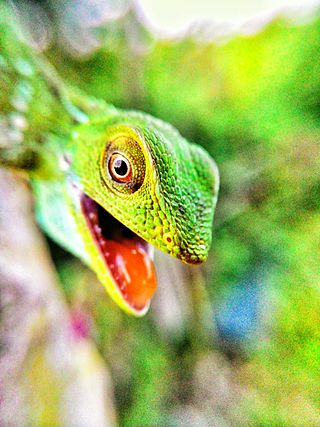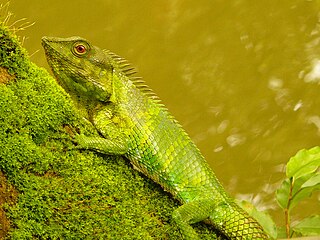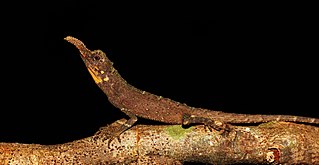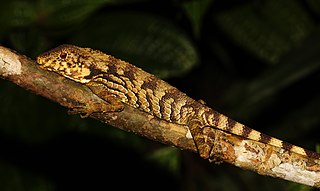
Calotes is a genus of lizards in the draconine clade of the family Agamidae. The genus contains 29 species. Some species are known as forest lizards, others as "bloodsuckers" due to their red heads, and yet others as garden lizards. The genus name Calotes has been derived from the Greek word Καλότης (Kalótës), meaning ‘beauty’, referring to the beautiful pattern of this genus.

Ceratophora is a genus of agamid lizards found in Sri Lanka. The male has a horn on its snout.

Pseudocalotes is a genus of lizards in the family Agamidae. The genus is endemic to Southeast Asia.

Bronchocela jubata, commonly known as the maned forest lizard, is a species of agamid lizard found mainly in Indonesia on the islands of Singkep, Java, Bali, Sulawesi, Karakelang, Salibabu; Nias Island, Singkap Island, Borneo (Kalimantan) also in Thailand, Cambodia and Philippines. Although in the past it was thought the species may be found in India, either on the mainland or in the Nicobars, this is not the case according to herpetologist Das. It is also known by the common name of "bloodsucker", although this is a misnomer.

Calotes calotes, the common green forest lizard, is an agamid lizard found in the forests of the Western Ghats and the Shevaroy Hills in India, and Sri Lanka.

Monilesaurus ellioti, also known commonly as Elliot's forest lizard, is a species of arboreal, diurnal, lizard in the family Agamidae. The species is endemic to the Western Ghats, India.

Calotes emma, commonly known as the forest garden lizard or Emma Gray's forest lizard, is a species of lizard in the family Agamidae. The species is native to China, South Asia, and Southeast Asia. There are two recognized subspecies.

Calotes maria, called commonly the Khasi Hills forest lizard or Assam garden lizard, is a species of lizard in the family Agamidae. The species is endemic to South Asia.

Calotes nemoricola, the Nilgiri forest lizard, is an agamid lizard found in the Western Ghats of India.

Monilesaurus rouxii, commonly known as Roux's forest lizard, Roux's forest calotes, or the forest blood sucker, is a species of arboreal, diurnal, agamid lizard, which is endemic to hills of peninsular India. In July 2018, it was proposed that the species should be transferred to the new genus Monilesaurus.
The Haly's tree skink is a species of lizard in the family Scincidae. The species is native to Sri Lanka. Earlier thought to be found also in the Western Ghats, taxonomic studies have shown D. haliana to be a Sri Lankan endemic, differentiated from the Indian D. subcaeruleum. D. haliana is the only arboreal skink in Sri Lanka.
Microauris is a monotypic genus of agamid lizard. Its only species is Microauris aurantolabium, also known as the small-eared dragon or orange-lipped forest lizard, found in the forests of the southern Western Ghats and is currently known from the Kalakkad Mundanthurai Tiger Reserve. The species was formerly included in Pseudocalotes andamanensis of the Andaman Islands, but recognized as distinct in 2008. It was also classified under Calotes until 2018, where it was transferred to its own genus, Microauris, on the basis of its divergence from Calotes.

The rough-nosed horned lizard or Sri Lanka horned agama is an Agamid lizard from Sri Lanka in lowland dipterocarp forests and secondary forests in the wet zone. It is distinguished from all the other Ceratophora species by the presence of a complex rostral appendage, comprising more scales than rostral scale alone. The lateral body scales are small and more or less regular shape.

Otocryptis wiegmanni, commonly called the brown-patched kangaroo lizard, Sri Lankan kangaroo lizard or Wiegmann's agama, is a small, ground-dwelling agamid lizard endemic to Sri Lanka.

The whistling lizard or Sri Lanka agama is a species of lizard in the family Agamidae. It is one of seven Calotes species endemic to Sri Lanka.

Calotes nigrilabris, the black-cheek lizard, is an agamid species endemic to Sri Lanka. It can be distinguished easily from painted-lipped lizard by having black bar on mouth rather than white or orange bar.

Ceratophora erdeleni, also known commonly as Erdelen's horned lizard or Erdelen's horn lizard, is a species of lizard in the family Agamidae. The species is endemic to Sri Lanka. It has only a rudimentary "horn", that is occasionally missing altogether.

The Pethiyagoda's crestless lizard is an agamid lizard endemic to Sri Lanka. Locally known as පෙතියාගොඩගේ නොසිලු කටුස්සා.
Sitana bahiri is an endemic species of agamid lizards recently found from Sri Lanka. The species was first found from Yala national park. The species was named in honor of M.M Bahir, who is one of a leading wildlife conservationist of Sri Lanka.
Sitana devakai is an endemic species of agamid lizards recently found from Sri Lanka. The species was first found from Puttalama district. The lizard is also known to found in Tamil Nadu of India, but not given valid identification. The species was named in honor of Dr. Devaka K. Weerakoon, who is a conservation biologist. He is a Professor of Zoology in University of Colombo.



















